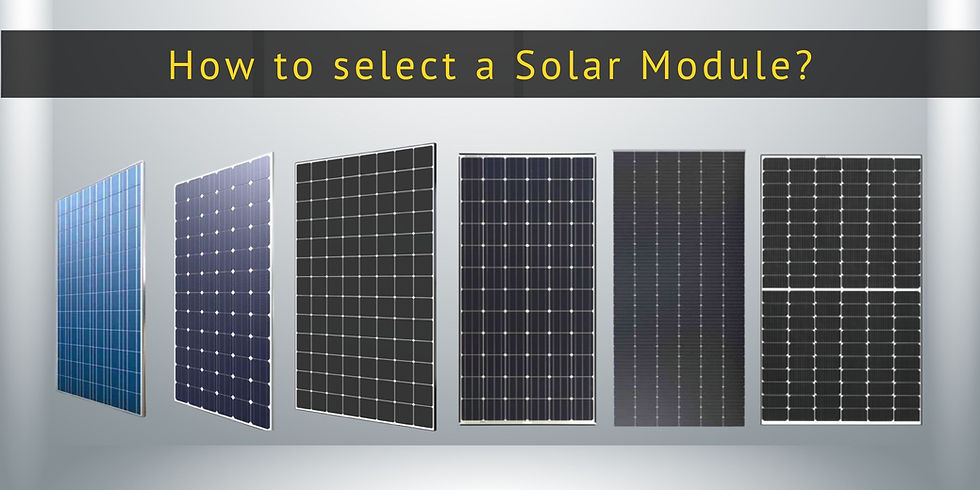Why is the Solar Inverter Capacity Lower than Solar Module Capacity - DC Overloading?
- Cares Renewables

- Aug 16, 2021
- 3 min read
Updated: Nov 15, 2021

We get numerous questions from our customers regarding the choice of Solar Inverter and Solar Module they plan to use in the Solar Plant. The queries related to DC Overloading of Solar Inverters is indeed one of the toughest:
Why is the peak AC output of the Inverter lower than the Solar Module Capacity?
Will my modules output be limited, as the Inverter capacity is 20% lower than the Solar Module Capacity?
Will the higher Solar Module capacity reduce the life of the Solar Inverter/Panel?
Are you trying to save cost by suggesting a lower capacity Inverter?
In this blog, we will focus on the pros and cons of DC Overloading in Solar Inverters. All good solar inverter brands allow DC overloading in the range of 25% to 50%. The extent of DC Overloading is a balance between:
The possible clipping of power that could happen in case of ideal weather conditions
vs.
The energy gain which you could achieve through overloading during less ideal conditions
Many times, the power gain and the overall business case due to overloading makes up for the power loss due to clipping.
We will look at four different aspects concerning DC Overloading:
Module Output at Standard Test Conditions vs Actual Site Conditions:
All Solar Modules are rated at Standard Test Conditions, which is 1000 Wp/m2 irradiation and a Module Cell Temperature of 25 deg C.
Solar Modules performance goes down when the temperature goes up, and the cell temperature is typically higher than the atmospheric temperature by ~10 to 20 deg or more. Under normal weather conditions, in most of the regions in India, the ideal conditions for peak performance of Solar Modules are never achieved. So the actual peak DC output from Solar Modules will be far lower than the rated voltage. (Typically 75 to 85%). Again this peak output is achieved only during peak noon hours for a few days in a year. So a panel rated at 400 Wp may give you the output of only 320 Wp. So it might make sense to go for a lower inverter capacity so that you can improve the utilization of the Solar Inverter.
The Normal Module Operating Temperature output given in the Solar Module Data Sheet might be a better Indicator of the actual peak output of the Solar Module under real-time conditions.
Sample NMOT for an REC Solar Module

Start Voltage of Inverters and Low Light Performance:
All solar inverters require a minimum DC voltage to start their operation. The same is specified as 'start voltage' in the datasheet. The higher DC capacity attached to an overloaded solar inverter may help it attain the start voltage required for the operation during low light conditions. So DC overloading may have an indirect benefit of improving the low light performance of the system.
Overloading and Efficiency Curve
Based on the efficiency curve of the solar-inverter and the climatic conditions in the region where the solar plant is located, DC overloading might help the inverter operate in a better region of the efficiency curve. For most of the inverters, the efficiency of the solar inverter is relatively low when inverters are underloaded.
Sample efficiency Curve of SMA Inverter for reference.

So overloading the inverter may improve the weighted efficiency of the Solar Inverter, leading to better yield.
Cost-benefit
Overloading has an obvious cost-benefit, as the per Wp cost for Solar Inverter comes down when we load a higher DC capacity against the AC Capacity of a Solar Inverter. However, an installer needs to be mindful of clipping losses, and the power gain from overloading while overloading the Inverter. Clipping losses occur when the actual solar power production exceeds the AC output of the Inverter. The excess solar power beyond inverter ac capacity will be clipped or lost.
Simulation tools might give you some idea of how much clipping loss you can expect with overloading the Inverter. However, an experienced installer with practical experience and data under different loading conditions in a region might be able to guide you better.
Sometimes, even if the total clipping loss is slightly higher, installer and customer may go for a high DC overloading considering the overall cost-benefit over a lifetime.
Since solar modules power output is expected to degrade every year (at rates varying from 0.35% to 1%), the clipping losses due to overloading will come down every year. So a 1% to 3% clipping loss in the first year of operation is not considered as a big loss by customers.
At Cares Renewables, we are focused on delivering quality solar power plant solutions to our customers and partners. Please leave a comment, if you have any queries on this blog. Visit https://www.caresrenewables.com/blog to explore our blogs section.




https://www.jaysis.ai/product/3kw-solar-panel-price-in-india-with-subsidy-monocrystalline/
With each advancement in solar panel technology, we inch closer to a future powered by clean and efficient energy sources.
<a href="https://www.jaysis.ai/product/3kw-solar-panel-price-in-india-with-subsidy-monocrystalline/">3kW Solar Panel Price In India With Subsidy</a>